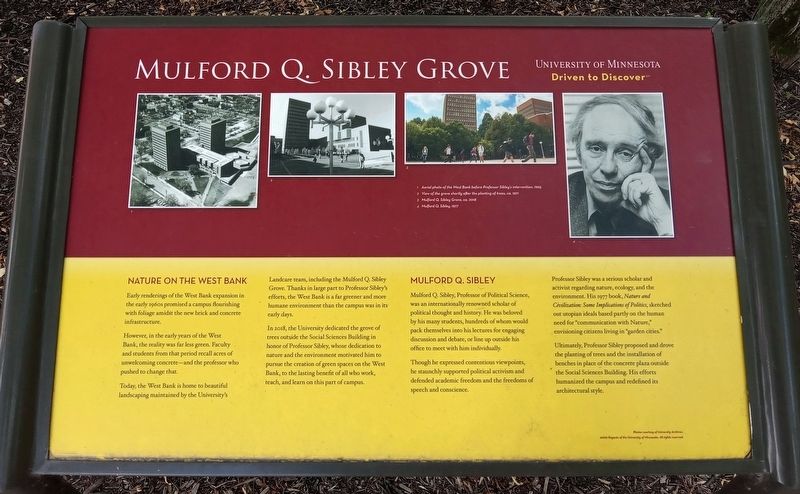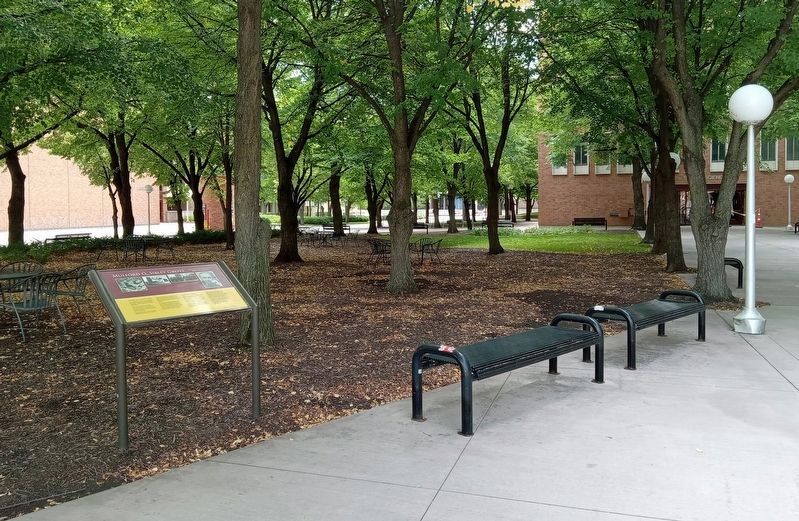University in Minneapolis in Hennepin County, Minnesota — The American Midwest (Upper Plains)
Mulford Q. Sibley Grove
1. Aerial photo of the West Bank before Professor Sibley's intervention, 1965
2. View of the grove shortly after the planting of trees, ca. 1971
3. Mulford Q. Sibley Grove, ca. 2018
4. Mulford Q. Sibley, 1977
Nature on the West Bank
Early renderings of the West Bank expansion in the early 1960s promised a campus flourishing with foliage amidst the new brick and concrete infrastructure.
However, in the early years of the West Bank, the reality was far less green. Faculty and students from that period recall acres of unwelcoming concrete—and the professor who pushed to change that.
Today, the West Bank is home to beautiful landscaping maintained by the University's Landcare team, including the Mulford Q. Sibley Grove. Thanks in large part to Professor Sibley's efforts, the West Bank is a far greener and more humane environment than the campus was in its early days.
In 2018, the University dedicated the grove of trees outside the Social Sciences Building in honor of Professor Sibley, whose dedication to nature and the environment motivated him to pursue the creation of green spaces on the West Bank, to the lasting benefit of all who work, teach, and learn on this part of campus.
Mulford Q. Sibley
Mulford Q. Sibley, Professor of Political Science, was an internationally renowned scholar of political thought and history. He was beloved by his many students, hundreds of whom would pack themselves into his lectures for engaging discussion and debate, or line up outside his office to meet with him individually.
Though he expressed contentious viewpoints, he staunchly supported political activism and defended academic freedom and the freedoms of speech and conscience.
Professor Sibley was a serious scholar and activist regarding nature, ecology, and the environment. His 1977 book, Nature and Civilization: Some Implications of Politics, sketched out utopian ideals based partly on the human need for "communication with Nature," envisioning citizens living in "garden cities."
Ultimately, Professor Sibley proposed and drove the planting of trees and the installation of benches in place of the concrete plaza outside the Social Sciences Building. His efforts humanized the campus and redefined its architectural style.
Erected 2009 by Regents of the University of Minnesota.
Topics. This historical marker is listed in these topic lists: Education • Parks & Recreational Areas. A significant historical year for this entry is 1960.
Location. 44° 58.322′ N, 93° 14.57′ W.
Marker is in Minneapolis, Minnesota, in Hennepin County. It is in University. Marker can be reached from S. 19th Avenue. The marker is on the University of Minnesota's West Bank campus, in the plaza between Anderson Hall and Blegen Hall, just south of the Washington Avenue Bridge. Touch for map. Marker is at or near this postal address: 269 S 19th Avenue, Minneapolis MN 55455, United States of America. Touch for directions.
Other nearby markers. At least 8 other markers are within walking distance of this marker. The West Bank (a few steps from this marker); A Legacy of Public Service (within shouting distance of this marker); A Global University (about 500 feet away, measured in a direct line); Distance Learning (about 700 feet away); You Are Here… Bohemian Flats (approx. 0.2 miles away); Old Portage Trail (approx. ¼ mile away); Rail Traffic in the Twin Cities (approx. 0.3 miles away); Spanning the Sciences (approx. 0.4 miles away). Touch for a list and map of all markers in Minneapolis.
Credits. This page was last revised on September 20, 2023. It was originally submitted on September 18, 2023, by McGhiever of Minneapolis, Minnesota. This page has been viewed 62 times since then and 13 times this year. Photos: 1, 2. submitted on September 18, 2023, by McGhiever of Minneapolis, Minnesota. • J. Makali Bruton was the editor who published this page.

